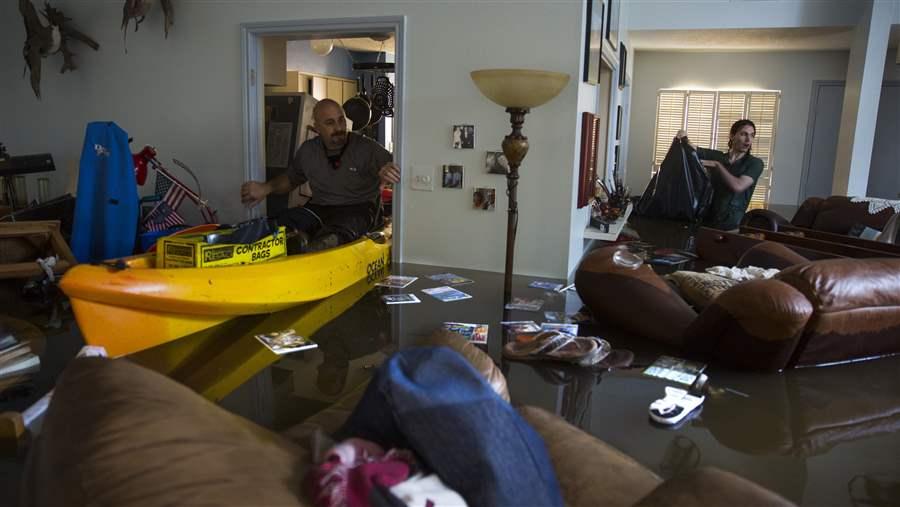To Help Future Hurricane Victims, Congress Must Fix Flood Insurance
Repeatedly flooded homes and weak mitigation have spiked program’s debt

Larry Koser Jr., left, searches his home in west Houston with his son Matthew for important papers and heirlooms after it was flooded by heavy rains from Hurricane Harvey.
Erich Schlegel/Getty ImagesToday, as part of a bill authorizing aid to Hurricane Harvey victims, Congress passed a three-month extension of the National Flood Insurance Program (NFIP) to keep it from expiring on Sept. 30. At the height of an active and deadly hurricane season, the extension ensures that the NFIP will continue providing flood insurance and processing claims for victims of Hurricane Harvey and other floods, which almost certainly will include major impacts from Hurricane Irma in the coming days.
With this short-term reauthorization in place, Congress should debate much-needed reforms to the national program, which insures nearly 5 million policyholders across all 50 states. The NFIP is already $25 billion in debt, which is why Congress must act soon to reform the program and provide it with a solid financial footing. The short-term NFIP extension should be followed by key changes to the program to reduce harm in future storms and lower costs to communities and government budgets.
Hurricanes Harvey and Irma underscore the substantial need to modernize the approach taken by the federal government to reduce flood risk. The Federal Emergency Management Agency (FEMA) has begun processing claims for homes and businesses affected by Harvey, and with Hurricane Irma threatening Florida the cost of losses and damages from the 2017 hurricane season is likely to be unprecedented.
The Pew Charitable Trusts urges Congress to include the following measures in NFIP reforms:
- Reduce the number of repeatedly flooded properties. Historically representing just 1 percent of NFIP policyholders but roughly 25 to 30 percent of claims, the number of repeatedly flooded properties has been growing by about 5,000 each year. A bill introduced in the Senate in June, the Repeatedly Flooded Communities Preparation Act, would require communities with large numbers of these properties to restrict growth and reduce risk.
- Require that homebuyers be informed of a property’s flood history. A single, national standard would ensure that prospective buyers know whether a property has flooded or is at risk of flooding. Under provisions in the 21st Century Flood Reform Act, which was introduced in the House of Representatives in July, states would enact laws that require sellers and lessors to provide information they know about a property’s flood history.
- Invest in mitigation before flood disasters strike. The State Flood Mitigation Revolving Fund Act of 2017, introduced in the Senate in June, would provide low-interest loans to homeowners, business owners, and communities for pre-disaster mitigation such as elevating structures and buying out property owners in high-risk areas, thus making communities more resilient. Additionally, Congress needs to adequately fund flood-risk maps, which are lacking for about two-thirds of the country.
Laura Lightbody directs The Pew Charitable Trusts’ flood-prepared communities initiative.









